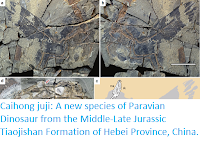The Maniraptorans were a highly diverse and successful group of Theropod Dinosaurs, whose members included the Dromaeosaurs, Troodontids and Birds. For a long while this group was overlooked in favour of more massive Theropod groups, however in recent years this group has been extensively studied, with numerous specimens discovered on several continents, leading to a better understanding of the group's evolution and diversity. The Oviraptorosaurs are a distinctive group of Maniraptorans known from the Cretaceous of Asia and North America, that are distinguished by having short, high skulls, long necks and short tails.
In a paper published in the journal Scientific Reports on 22 March 2018, Yilun Yu of Yuan Pei College at Peking University, Kebai Wang and Shuqing Chen of the Zhucheng Dinosaur Museum, Corwin Sullivan of the Department of Biological Sciences at the University of Alberta, and the Philip J. Currie Dinosaur Museum, Shuo Wang of the Laboratory of Vertebrate Evolution at Capital Normal University and the State Key Laboratory of Palaeobiology and Stratigraphy at the Nanjing Institute of Geology and Palaeontology, Peiye Wang, also of the Zhucheng Dinosaur Museum, and Xing Xu of the Key Laboratory of Vertebrate Evolution and Human Origins at the Institute of Vertebrate Paleontology and Paleoanthropology of the Chinese Academy of Sciences, describe a new species of Oviraptorosaur from the Cretaceous Wangshi Group of Shandong Province, China.
The Late Cretaceous Wangshi Group outcrops at at least three locations near Zhucheng City in Shandong Province, China, producing numerous Dinosaur fossils from within a very short geological timeframe. This assemblage is dominated by large Hadrosaurs, but has produced fossils belonging to other groups, including Tyrannosaurids and Ceratopsids.
The new species is named Anomalipes zhaoi, where ‘Anomalipes’ means ‘anomalous foot’ and ‘zhaoi’ honours palaeontologist Xijin Zhao for his work on the Zhucheng dinosaur fossils. The new species is described from a partial left hind limb, comprising part of the femur, fibular and tibia, the third metatarsal and two phalanges. These were found disarticulated but in close proximity, and are presumed to be from the same animal due to an absence of any other Theropod material in the area.
In a paper published in the journal Scientific Reports on 22 March 2018, Yilun Yu of Yuan Pei College at Peking University, Kebai Wang and Shuqing Chen of the Zhucheng Dinosaur Museum, Corwin Sullivan of the Department of Biological Sciences at the University of Alberta, and the Philip J. Currie Dinosaur Museum, Shuo Wang of the Laboratory of Vertebrate Evolution at Capital Normal University and the State Key Laboratory of Palaeobiology and Stratigraphy at the Nanjing Institute of Geology and Palaeontology, Peiye Wang, also of the Zhucheng Dinosaur Museum, and Xing Xu of the Key Laboratory of Vertebrate Evolution and Human Origins at the Institute of Vertebrate Paleontology and Paleoanthropology of the Chinese Academy of Sciences, describe a new species of Oviraptorosaur from the Cretaceous Wangshi Group of Shandong Province, China.
The Late Cretaceous Wangshi Group outcrops at at least three locations near Zhucheng City in Shandong Province, China, producing numerous Dinosaur fossils from within a very short geological timeframe. This assemblage is dominated by large Hadrosaurs, but has produced fossils belonging to other groups, including Tyrannosaurids and Ceratopsids.
The new species is named Anomalipes zhaoi, where ‘Anomalipes’ means ‘anomalous foot’ and ‘zhaoi’ honours palaeontologist Xijin Zhao for his work on the Zhucheng dinosaur fossils. The new species is described from a partial left hind limb, comprising part of the femur, fibular and tibia, the third metatarsal and two phalanges. These were found disarticulated but in close proximity, and are presumed to be from the same animal due to an absence of any other Theropod material in the area.
Preserved pedal elements of Anomalipes zhaoi. Left metatarsal III in lateral (a), medial (b), posterior (c), anterior (d), proximal (e) and distal (f) views. Dark lines indicate ridges on the posterior surface of the shaft. Phalanx IV-1 in lateral (g), medial (h), proximal (i), and distal (j) views. Phalanx II-3 in lateral (k) and medial (l) views. Abbreviations: fl, flexor tubercle; lc, lateral condyle; lgf, ligament fossa; pdc, proximal dorsal crest; pdl, proximal dorsal lip; vr, ventral ridge; ptaf, proximal triangular articular facet; rlmh, ridge-like medial hemicondyle; vr, ventral ridge (extending to medial hemicondyle). Scale bars are 1 cm. Yu et al. (2018).
See also...
Follow Sciency Thoughts on
Facebook.







